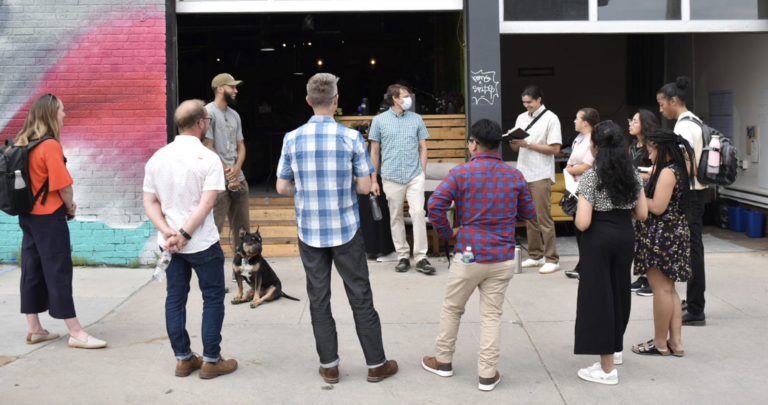By Sarah Konradi, executive director, Design Workshop Foundation, and Jevon Taylor, CEO, Green Spaces, Green Dot Coalition


Engaging with your local community takes many forms — canned food drives, volunteer events, and employee giving campaigns. Call it Corporate Social Responsibility (CSR), or just plain old common sense, good business leaders know they have a commitment to driving positive change in the communities where they have roots.
Design Workshop and Design Workshop Foundation are rethinking the way we engage with the community. For the past two years, Design Workshop Foundation, a 501c3 nonprofit organization with a mission to catalyze transformative change in communities, has been collaborating with Denver’s Green Dot Coalition, a community-led organization rooted in Denver’s historic Five Points Neighborhood.
The Green Dot partners are seeking to build climate resiliency in Denver neighborhoods that have been historically overlooked in areas of tree planting and green infrastructure. Our organizations have worked closely to host volunteer planting days and advance shared goals of a healthier, greener Denver. We can provide all the technical assistance and capacity support in the world, but their efforts also require money. Fundraising for community nonprofits is a way to leverage an organization’s resources in direct support of those engaged in boots-on-the-ground program work.
Rather than simply making cash donations, businesses should look at offering their time and talent to host a community fundraising event aimed at growing support for their community-led work. Here are five tips and ideas to consider for those organizations seeking to collaborate on a fundraising event with nonprofit partners.
1) Make it Bigger than You
What about your event entices someone to attend? Compelling events should include opportunities for direct connection to a cause or purpose. Consider including an engaging and informative education session in the form of a short video or guest experts as a part of the event, so that attendees walk away inspired and armed with knowledge. Ultimately, you want attendees to continue engaging with the organization and supporting their work in the future. Use this as an opportunity to build their
understanding of the issues, take the first step of financial support and open the door to future engagement.
2) Tell a Story
Consider how you can support elevating the voices of those in the community that are directly benefitting from the nonprofits’ efforts. How does the organization hope to build on current impactful work? What does the future look like if they are to be successful in their mission? Let attendees hear directly from those who benefit from the nonprofit’s program efforts — don’t tell others’ stories, but rather elevate their voices. Remember that there are many chapters in the story of a community, be sure to share a variety of inclusive stories that highlight your current collaborations but don’t diminish other community efforts.
3) Co-create for Immediate Impact
Roll up your sleeves and build or create something that’s interactive with a purpose. A community-created art installation? Blankets for the unhoused? Garden kits that get distributed to local schools?
What creative and hands-on activity advances the nonprofit’s mission immediately? Make your convening purposeful and powerful by creating something that can immediately be deployed to the community.
4) Keep it Local
Take intentional steps to integrate the community into the event and be a model for collaboration. Are there local artisans, restaurants, and others whose craft you can elevate and introduce to new audiences? Showcase the local ecosystem in new ways and identify small businesses that can be important contributors to the event. Remember that community stakeholders come in many different forms — these business owners can be important contributors to the event and the nonprofit.
5) Broaden the Base
Help nonprofits reach beyond their traditional audience to spread their message further by bringing new constituents to the table. The reach of your corporate connections may be one of your greatest assets– leverage your connections to create an expanded audience who can contribute to the sustainability of the nonprofit’s efforts. Real community-driven change is best described as “a lot of a little, rather than a little of a lot,” and building your event around this philosophy can help set the nonprofit up for future success with a broader base of support.
It’s imperative for more organizations to be progressive partners and meet the community where they are. Tackling the challenges of our time requires multifaceted and multidisciplinary inputs and solutions. Moving beyond the check offers capacity-building support as an innovative approach to community involvement centered in equity. This helps to position nonprofit organizations serving under-resourced communities to better respond to critical and emergent challenges, backed by partnerships with trusted corporate partners. Together, along with our Green Dot Coalition partners, we are taking a context-based approach and generating both capacity and funding to fuel the work into the future.









